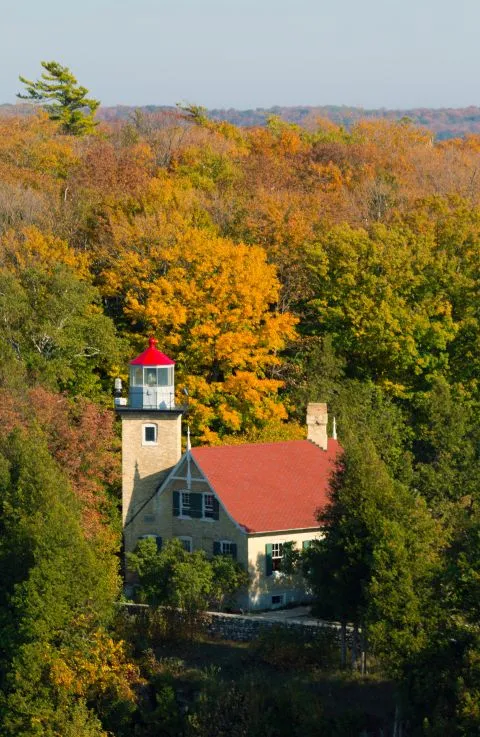As the Civil War’s firestorm was extinguished, and the North and South stood once more united, pioneers discovered the riches of northeastern Wisconsin. But the trek westward from the cultured east coast was challenging, an arduous journey of hundreds of miles across the frontier. Traveling through the St. Lawrence Seaway, down the Erie Canal, and through the Great Lakes, the schooners and steamboats carried immigrants and settlers. The journey was long and difficult…the waters dangerous. If not for the lighthouses hugging the shoreline, clinging to rocky bluffs, or speckling solitary islands, many a ship would never have seen dry land.
Perched on a bluff 76 feet above Green Bay’s glistening waters, Eagle Bluff Lighthouse’s lamp brought solace to many a sailor suffering through a storm’s gale or the dark of night. Today the tradition of the lighthouse continues. Restored to its past glory, by the Door County Historical Society, Eagle Bluff Lighthouse is a tribute to the keepers who kept the lamp burning on many a dark and stormy night.
Guiding guests through the lighthouse and its grounds, knowledgeable tour guides share the personal stories of the keepers who manned the light from 1868 – 1926. Decorated with some of the keepers’ original furnishings, as well as authentic period antiques, the Eagle Bluff Lighthouse tells the story of not only the men who toiled through the night, but also their wives and children.
A visit to Eagle Bluff Lighthouse Museum provides a glimpse into the past…the maritime and navigational history that is the peninsula’s legacy to the future. In memory of the past keepers and their dedication to providing safe passage, the Eagle Bluff Lighthouse Museum continues in their tradition.
The Great Lakes region was ripe with opportunity following the formation of the Northwest Territory in 1800. Fertile land for pennies on the dollar captured the imagination of the settlers and immigrants arriving via the Erie Canal. Lush forests provided timber for the construction of homes and barns; fish and game were plentiful. And so the new settlers arrived from all corners of the globe.

By 1835, the northeastern-most tip of the state welcomed its first white settler, Increase Claflin. Soon, villages were established up and down the shores of the peninsula. And before long, the Door County was a patchwork of homesteads scattered throughout its countryside. In the aftermath of the Civil War, Wisconsin’s hinterland had been tamed.
With the influx of people to the region and the increasing demand for goods, shipping across the Great Lakes’ waters increased. Submerged shoals, unmarked routes, dangerous straits, and narrow entrances to harbors and rivers caused countless ships to disappear beneath the swirling waters. In response to the pleas for navigational aids in the region, the United States government constructed lighthouses throughout the Great Lakes. Eventually, 344 major lighted aids would dot their shores.
By 1899, 12 lighthouses illuminated Door County’s 300-mile shoreline and islands. Eagle Bluff Lighthouse, constructed in the midst of the growing demand for navigational aids, was operational on October 15, 1868. Situated on a bluff overlooking Green Bay, Eagle Bluff Lighthouse was constructed for $12,000. In addition to Cream City brick shipped from Milwaukee, materials and supplies arrived by water from Chicago and Detroit.
Eagle Bluff Lighthouse immediately gained status as an important navigational aid for ships passing through the Strawberry Channel, a narrow passage populated by four islands. Congested with ships delivering people and cargo to and from the villages along the peninsula’s coastline, the lighthouse provided safe passage through rough seas and dangerous waters by way of its Fresnel lens.
Although lighthouses could be solitary and lonely, Eagle Bluff Lighthouse was far from isolated. Only three miles from the villages of Fish Creek in one direction and Ephraim in the other, Eagle Bluff Lighthouse was a destination for friends, family, and visitors from as far away as Chicago. Managed and maintained by three lighthouse keepers and their families for a period of 58 years, it was commonplace for the house to host parties and special events.
The first keeper, Henry Stanley, and his wife served from 1868 – 1883 when he was transferred to the new Sherwood Point Lighthouse in southern Door. The second keeper lived and worked at Eagle Bluff for 35 years. William Duclon and his wife Julia raised seven sons in the lighthouse, some of whom served as lifesavers. Following the couple’s retirement in 1918, Peter Coughlin was appointed the final keeper. When the lamp was automated with acetylene gas in 1926, the keepers’ residential tenure at Eagle Bluff ended.
During the course of its history, the lighthouse on the bluff was first owned and operated by the United States government. With the establishment of Peninsula State Park, maintenance of Eagle Bluff Lighthouse later passed to the Wisconsin Department of Natural Resources. In 1960, after years of neglect, the Door County Historical Society was granted permission to restore the lighthouse and provide access for visitors. Following an arduous four-year restoration program and hundreds of hours of research, Eagle Bluff Lighthouse opened to the public in 1964. Furnished with authentic period pieces and donations from the Historical Society members, the Eagle Bluff Lighthouse provides a unique experience for visitors and guests.

Today, Eagle Bluff’s light is visible every night of the year. Summer boaters identify their position in the water by an assigned code of one second on, six seconds off. Winter snowmobilers find safety on the ice under the light’s steady flash. Visitors to Eagle Bluff Lighthouse are always surprised to learn that its lamp has remained constant for the past 150 years, the Eagle Bluff Lighthouse has protected the waters of the Strawberry Channel…and hopefully, the light will continue to serve as a beacon for many years to come.
